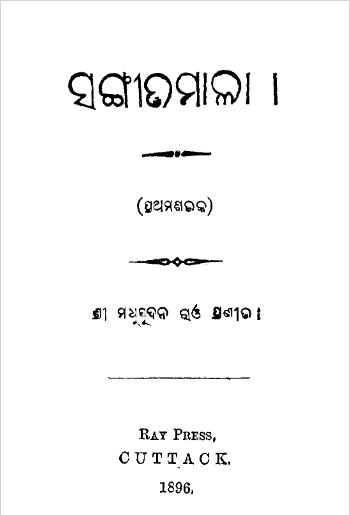Sangitamala, published in 1896 by one of the pioneering figures in Odia literature, Madhusudan Rao, is a remarkable anthology that showcases the depth and richness of Odia poetry. Known for his lyrical prowess and emotional depth, Rao’s work in Sangitamala not only reflects the cultural ethos of his time but also contributes significantly to the development of modern Odia literature. This collection serves as a celebration of love, nature, and the human experience, intertwining music and poetry in a harmonious blend.
Sangitamala, which translates to A Garland of Songs, aptly describes the essence of the collection as a bouquet of poetic expressions. Each poem encapsulates a different facet of life and emotion, evoking a range of feelings from joy and love to sorrow and introspection. Madhusudan Rao draws inspiration from the world around him, using nature as a backdrop for his explorations of human emotions.
The anthology features a diverse array of themes, including romantic love, the beauty of nature, social issues, and philosophical musings. This thematic diversity not only keeps the reader engaged but also reflects the complexity of human experience. Rao’s ability to weave personal sentiments with broader societal reflections demonstrates his keen awareness of his surroundings and his desire to resonate with a wide audience.
Madhusudan Rao is celebrated for his lyrical and musical style of writing. The very structure of Sangitamala invites readers to not just read but to feel the rhythm and melody of the verses. His mastery of the Odia language is evident in the way he employs alliteration, assonance, and vivid imagery to create a musical quality in his poetry. Each poem flows seamlessly, echoing the idea that poetry is akin to song—a sentiment that deeply resonates with the title.
The use of nature imagery is particularly prominent in Rao’s work. He often evokes the beauty of landscapes, seasons, and the changing elements to mirror the emotional states of his characters. For instance, a blooming flower may symbolize love, while a stormy sky could represent turmoil or despair. This connection between nature and emotion not only enriches the reader’s experience but also aligns with the Romantic ideals prevalent during the late 19th century.
Sangitamala emerges from a period of significant transformation in Odisha, where literature began to play an essential role in the cultural revival of the region. Madhusudan Rao’s work reflects the influences of the broader literary movements occurring across India at the time, including the impact of Romanticism. His poems often carry a socio-political tone, subtly addressing issues of identity and culture, which were crucial during the colonial era.
As one of the early anthologies in Odia poetry, Sangitamala paved the way for future generations of poets. It inspired a literary awakening in Odisha, encouraging writers to explore emotional depth and cultural themes in their works.
Books Info
| Books name | Sangitamala / ସଂଗୀତମାଳା |
| Author | Madhusudan Rao |
| No Of pages | 85 |
| Publisher | NA |
| Publication | 1896 |
| Printed At | Ray Press |
| Distributor | NA |

